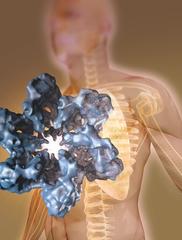URL: https://www.desy.de/news/news_search/index_eng.html
Breadcrumb Navigation
DESY News: How do tuberculosis bacteria attack human cells?
News
News from the DESY research centre
How do tuberculosis bacteria attack human cells?
An international team of scientist from Hamburg, Vienna and Amsterdam has come one step closer to understanding how tuberculosis bacteria infect human cells. The study published in the scientific journal Nature Microbiology reveals the molecular structure of a membrane channel that plays a key role in the infection. The team including scientists from the European Molecular Biology Laboratory EMBL Hamburg branch and the new Centre for Structural Systems Biology CSSB, both on the DESY campus in Hamburg, present the first molecular structure of the type VII secretion system of mycobacteria such as Mycobacterium tuberculosis.

Single particle electron microscopy analysis conducted by the group of Thomas Marlovits at the Research Institute of Molecular Pathology IMP in Vienna and the Institute of Molecular Biotechnology of the Austrian Academy of Sciences revealed that the type VII secretion system is comprised of four types of proteins that form a hexameric ring around a central pore. The system also has flexible molecular arms that reach into the interior of the bacterial cell and grasp molecules that need to be transported.
“One often thinks of protein structures as rigid entities,” explains Marlovits, who has joined the Medical Center Hamburg-Eppendorf UKE and DESY to head a new research group at CSSB. “However we observed a novel architectural principle in which a combination of structure and flexibility enable the functioning of the secretion system.” Investigations with the bright X-rays from DESY's light source PETRA III at an EMBL experimental station in Hamburg proved the great flexibility of the molecular arms.
Further biochemical and genetic experiments at the Vrije Universiteit Amsterdam support the structural data and provide in vivo insights into the components required for assembly of the secretion system. Future collaborative research will provide additional information regarding how the VII system is assembled and could help facilitate the development of novel medication designed to block this transport system.
“This study would not have been possible without the international and interdisciplinary collaboration enabled by the CSSB,” emphasises Wilmanns. “Each group was able to bring their specific knowledge and expertise to this project,” explains Marlovits. “It is only by combining the different technologies and techniques available in each location that we were able to solve and verify the structure of the type VII secretion system.”
Reference:
Structure of the mycobacterial ESX-5 type VII secretion system membrane complex by single particle analysis; Katherine S.H. Beckham, Luciano Ciccarelli, Catalin M. Bunduc et al.; „Nature Microbiology“, 2017; 10.1038/nmicrobiol.2017.47
Further reading:
CSSB
EMBL-News
Press release and illustration from IMP



